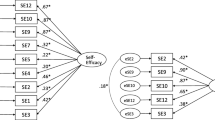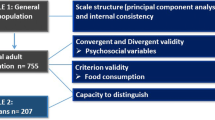Abstract
It is very important to determine the consumption of sugar-sweetened beverages that cause diseases, such as obesity, diabetes, hypertension, and cardiovascular disease in late adolescence. This study aimed to evaluate the validity and reliability of the Turkish version of the Sugar-Sweetened Beverages Media Literacy Scale aimed at university students. This methodological-descriptive-correlational study was conducted with 884 university students between September 2018 and December 2018. The data were collected using a socio-demographic data collection form and the Sugar-Sweetened Beverages Media Literacy Scale. Factor analysis, Cronbach’s alpha, and item-total correlation were used to evaluate the data. It was determined that the scale consists of 19 items and three sub-dimensions; the three sub-dimensions explained 49.9% of the total variance. In both the explanatory and confirmatory factor analyses, all the factor loads were found to be >0.30. In confirmatory factor analysis, it was found that all of the fit indices were > 0.85 and the root mean square error of approximation (RMSEA) was <0.080. Cronbach’s alpha was found to be 0.86 for the entire scale; the Cronbach’s alpha values for all three sub-dimensions were found to range between 0.65 and 0.84. In this study, the Turkish version of the Sugar-Sweetened Beverages Media Literacy Scale aimed at university students was found to be a valid and reliable measurement tool for the Turkish sample.

Similar content being viewed by others
References
Aksayan, S., & Gözüm, S. (2002). Kültürlerarası ölçek uyarlaması için rehber I: Ölçek uyarlama aşamaları ve dil uyarlaması. Hemşirelik Araştırma Dergisi, 4(1), 9–14.
Aufderheide, P. (1993). Media literacy: A report of the national leadership conference on media literacy. Washington, DC: Aspen Institute.
Bogart, L. M., Cowgill, B. O., Sharma, A. J., Uyeda, K., Sticklor, L. A., Alijewicz, K. E., & Schuster, M. A. (2013). Parental and home environmental facilitators of sugar-sweetened beverage consumption among overweight and obese Latino youth. Academic Pediatrics, 13, 348–355.
Çam, M. O., & Baysan-Arabacı, L. (2010). Qualitative and quantitative steps on attitude scale construction. Hemar-G, 12(2), 59–71.
Chandoni, P., & Wansink, B. (2006). Can “low-fat” nutrition labels lead to obesity? American Marketing Association, 43, 605–617.
Chen, Y., Porter, K. J., Estabrooks, P. A., & Zoellner, J. (2017). Development and evaluation of the sugar-sweetened beverages media literacy (SSB-ML) scale and its relationship with SSB consumption. Health Communication, 32(10), 1310–1317.
DeVellis, R. F. (2012). Scale development, theory and applications (3rd ed.pp. 31–59). India: SAGE Publication Inc.
Federal Trade Commission. (2008). Marketing food to children and adolescents: A review of industry expenditures, activities, and self-regulation. http://www.ftc.gov/reports/marketing-food-children-adolescents-review-industry expenditures-activities-self-regulation. Accessed 20 Mar 2019.
Harris, J. L., & Bargh, J. A. (2009). Television viewing and unhealthy diet: Implications for children and media interventions. Health Communication, 24, 660–673.
Hayran, M., & Hayran, M. (2011). Basic statistic for health researh. Ankara, Art Ofset Matbacılık Yayıncılık Org. Ltd Şti, 132–332.
Healy, A. M. (2013). Artificial sweeteners and high-fructose corn syrup: Effects on diabetes and weight. Integrative Medicine Alert, 16, 114–119.
Hennessy, M., Bleakley, A., Piotrowski, J. T., Mallya, G., & Jordan, A. (2015). Sugar-sweetened beverage consumption by adult caregivers and their children: The role of drink features and advertising exposure. Health Education & Behavior, 42, 677–686.
Hooper, D., Coughlan, J., Michael, R., & Mullen, M. R. (2008). Structural equation modelling: Guidelines for determining model fit. Electronic Journal of Business Research Methods, 6(1), 53–60.
Jeong, S., Cho, H., & Hwang, Y. (2012). Media literacy interventions: A meta-analytic review. Journal of Communication, 62, 454–472.
Jonhson, B., & Christensen, L. (2014). Educational research: Quantitative, qualitative, and mixed approaches (pp. 190–222). California: SAGE Publication, Inc.
Kit, B. K., Fakhouri, T. H. I., Park, S., Nielsen, S. J., & Ogden, C. L. (2013). Trends in sugar-sweetened beverage consumption among youth and adults in the United States: 1999–2010. American Journal of Clinical Nutrition, 98, 180–188.
Malik, V. S., Pan, A., Willett, W. C., & Hu, F. B. (2013). Sugar-sweetened beverages and weight gain in children and adults: A systematic review and meta-analysis. The American Journal of Clinical Nutrition, 98(4), 1084–1102.
Nielsen, S. J., & Pompkin, B. M. (2004). Changes in beverage intake between 1977 and 2001. American Journal of Preventive Medicine, 27, 205–210.
Nunnally, J. C., & Bernstein, I. H. (2010). Psychometric theory (3rd ed.). New York: McGraw-Hill.
Özdamar, K. (2005). Paket programlar ile istatistiksel veri analizi. 4. Baskı. Eskişehir: Kaan Kitabevi, 661–73.
Polit, D. F., Beck, C. T., & Owen, S. V. (2007). Is the CVI an acceptable indicator of content validity? Appraisal and recommendations. Research in Nursing & Health, 30(4), 459–467.
Primack, B. A., & Hobbs, R. (2009). Association of various components of media literacy and adolescent smoking. American Journal of Health Behavior, 33, 192–201.
Rattray, J., & Jones, M. C. (2007). Essential elements of questionnaire design and development. Journal of Clinical Nursing, 16, 234–243.
Sanchez-Lozada, L. G., Tapia, E., Jimenez, A., Bautista, P., Cristóbal, M., Nepomuceno, T., et al. (2007). Fructose-induced metabolic syndrome is associated with glomerular hypertension and renal microvascular damage in rats. American Journal of Physiology. Renal Physiology, 292, 423–429.
Scheibe, C., & Rogow, F. (2004). 12 basic principles for incorporating media literacy and critical thinking into any curriculum. Ithaca: Project Look Sharp.
Şencan, H. (2005). Sosyal ve davranışsal ölçümlerde güvenilirlik ve geçerlilik (reliability and validity in cocial and behavioral measurement) (1st ed.p. 107). Ankara: Seçkin Yayınevi.
Şimşek, Ö. F. (2010). Yapısal eşitlik modellemesine giriş temel ilkeler ve LISREL uygulamaları. İstanbul: Ekinoks.
Terwee, C. B., Bot, S. D., de Boer, M. R., van der Windt, D. A., Knol, D. L., Dekker, J., et al. (2007). Quality criteria were proposed for measurement properties of health status questionnaires. Journal of Clinical Epidemiology, 60(1), 34–42.
Welsh, J. A., Sharma, A. J., Grellinger, L., & Vos, M. B. (2011). Consumption of added sugars is decreasing in the United States. The American Journal of Clinical Nutrition, 94(3), 726–734.
Xi, B., Huang, Y., Reilly, K. H., Li, S., Zheng, R., Barrio-Lopez, M. T., Martinez-Gonzalez, M. A., & Zhou, D. (2015). Sugar-sweetened beverages and risk of hypertension and CVD: A dose-response meta-analysis. The British Journal of Nutrition, 113(5), 709–717.
Acknowledgements
The cooperation of the professors and students is gratefully acknowledged.
Author information
Authors and Affiliations
Corresponding author
Ethics declarations
Conflict of Interest
The authors declare that they have no conflict of interest.
Human and Animal Rights
This article does not contain any studies with human participants or animals performed by any of the authors.
Informed Consent
Informed consent was obtained from all the individual participants that were included in the study.
Additional information
Publisher’s note
Springer Nature remains neutral with regard to jurisdictional claims in published maps and institutional affiliations.
Rights and permissions
About this article
Cite this article
Demir, D., Bektas, M., Demir, S. et al. Psychometric properties of the Turkish version of the Sugar-Sweetened Beverages Media Literacy Scale for university students. Curr Psychol 40, 2561–2569 (2021). https://doi.org/10.1007/s12144-019-00325-7
Published:
Issue Date:
DOI: https://doi.org/10.1007/s12144-019-00325-7




